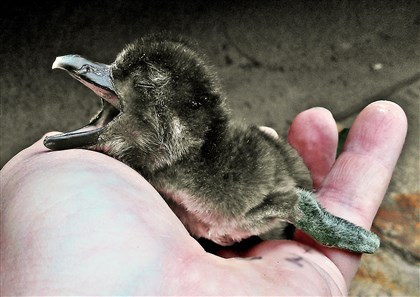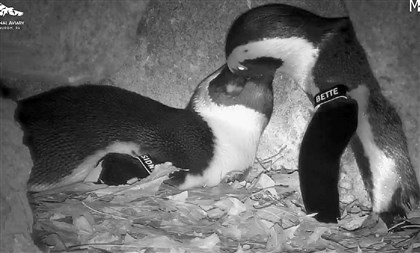In the world of African penguin conservation, every egg hatched, in the wild or in a zoo setting, represents hope for the future of this endangered species, whose population has declined precipitously from a million birds to fewer than 20,000 in less than a hundred years.
Last week Sidney and Bette, a nesting pair of African penguins at the National Aviary, had their third successful nesting in as many years. African penguins are monogamous and remain mated for life, which can be 25 years or more in captivity. Sidney and Bette’s latest clutch of two eggs hatched Dec. 15 and 18. For the first time, the public can watch our growing penguin family as it goes about its business in a private nesting burrow, thanks to a high-resolution infrared nest camera donated and installed by M&P Security Solutions.
When they hatched, both penguin chicks were only a little bigger than a golf ball in size, weighing less than a quarter of a pound. At first the chicks were nourished by the yolk sac inside their abdomens, which also contains important maternal antibodies, but within a couple of days, the parents were feeding them a rich diet of partially digested fish. Because newly hatched penguin chicks can’t regulate their own body temperatures, for the first few weeks they are continuously brooded (kept warm) by one of the parents.
Within a week after hatching, the chicks actively beg for food, poking repeatedly at the parent penguins’ beaks. When a parent obliges by opening its beak, the ravenous chicks thrust their whole head into the adult penguin’s throat in order to slurp up the nutritious slurry of regurgitated fish.
African penguin chicks grow very quickly, doubling or even tripling their weight week by week. By the time they reach full size, which takes about eight weeks, they have grown an incredible 2,000 percent from the weight of a half a stick of butter to that of a half a gallon of milk.
If you watch the penguin nest cam (www.penguinnestcam.org) over the holidays, you may see our devoted mated pair of penguins greet one another by “billing,” which is the quick tapping of their bills together. You may also see them allopreening, where each uses its beak to preen the feathers of the other. These behaviors are how penguins show their commitment to one another. By now the pair’s two fuzzy dark gray chicks are becoming much more mobile, trying to wiggle out from underneath their parents more and more often.
On this night before Christmas, National Aviary African penguin parents Sidney and Bette are a very busy, busy, busy pair of penguins indeed!
source




















No comments:
Post a Comment